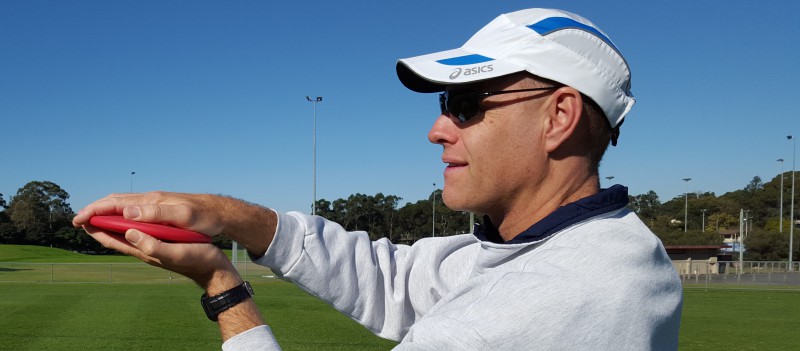Tips to Help Young Athletes Develop a Long Jump Run-Up
How should a young athlete measure out their long or triple jump run-up? Where should they start on the runway? How long should their run-up be? These are some of the most common questions that I am asked.
Firstly, it is worth knowing that a young athlete can use exactly the same run-up for both the long jump and the triple jump. Therefore, once an athlete has developed a long jump run-up, they also have a triple jump run-up.
My method for determining where an athlete should start on the runway is outlined in the seven following steps:
Step 1:
Firstly, the coach needs to have an idea of what is an appropriate length run-up for a young athlete. This can be done by matching their age with a recommended number of strides in their run-up. As a starting guide:
- 10 years = 10-11 strides
- 11 years = 10-12 strides
- 12 years = 11-13 strides
- 13 years = 12-14 strides
- 14 years = 13-15 strides
- 15 years = 14-16 strides
- 16 years = 15-17 strides
- 17 years = 15-21 strides
Step 2:
Find out which foot the athlete jumps off. Is it their left or right foot that hits the board? This is their “take-off” foot.
Step 3:
Ask the athlete to show you how they like to stand at the start of their run-up. Is their take-off foot forward or back? If it is forward, the athlete will need to take an even number of steps in their run-up to ensure that this foot hits the board. If it is back, they will need to take an odd number of steps in their run-up.
(TIP: Some athletes will tell you that they “don’t know” which foot they like forward at the start of a long jump run-up. If this occurs, ask them to show you a standing “On Your Marks” racing position. The position that they take is generally how they will begin their long jump run-up).
PDF Download: Click here to grab your enhanced copy of this article for just $1.99 AUD
Step 4:
Using the information gained from Steps 1-3 you can now determine the exact number of strides that the athlete will initially use in their run-up.
e.g. A 13-year-old athlete should take about 12-14 strides in their run-up. If they take-off to jump from their right foot and stand at the start of their run-up with this foot back, they need to take an odd number of strides. Therefore, the coach would advise the athlete to take 13 strides in their run-up.
If this same athlete likes to start their run-up with their take-off foot forward and therefore needs to use an even number of strides (12 or 14) to hit the board, I advise using the lower number (12) first and later lengthening the run-up to 14 strides if the athlete and/or coach feels that a 12-stride run-up is too short.
Step 5:
Ask the athlete to stand on the runway with their back to the sandpit and with the heel of their front foot on the take-off board foul line. They should stand exactly as they would to begin a long jump run-up. The athlete then runs up the runway, away from the pit, as you count their strides and then place a marker (e.g. some tape) where the “take-off” (e.g.13th) stride falls.
Repeat the above three times; preferably five times if possible. (Allow the athlete to rest between each!) You will finish with 3 or 5 markers next to the runway, depending on the number of times you repeat the exercise.
Once done, leave the middle of the 3 or 5 markers in place and remove the others. The remaining marker is from where the athlete can now practice their run-up.
(TIP: The athlete should run away from the pit as if they are running towards the pit – fast and with building speed. Discourage the athlete from counting their steps; this is the coach’s role. Simply ask the athlete to run to a point along the runway which will be well past their “take-off” stride).
Step 6:
Now facing the pit, the athlete places their front foot next to the marker, runs back towards the board and “pops-up” (takes off) into the pit. Note where their last (take-off) stride lands in relation to the take-off board.
Repeat the above several times. If the athlete’s foot is consistently behind the take-off board, say 20cm, then move the start marker 20cm forward. If their foot is beyond the take-off board then move the marker back. Try to avoid moving the marker after every trial run. Only move it once it is obvious that you have to.
Repeat the run-up and marker adjustment a few times to establish a consistent approach run onto the take-off board.
(TIP: Never allow the athlete to just “run through” and step on the board to test their run-up. They need to at least complete the take-off phase of the jump to properly assess the run-up’s accuracy).
Step 7:
Once you and the athlete are happy with their run-up and they are hitting the board relatively consistently, measure the distance accurately with a tape measure and record it for future use.
(TIP: Pull the tape measure along the edge of the runway, not down the middle, to ensure that it is straight).
Note:
- It is important to be aware that a headwind or tailwind will affect the run-up. A headwind may mean moving the marker slightly forward and a tailwind may mean moving the marker slightly back.
- The above is a starting point. As the run-up is fine-tuned, an athlete and coach may experiment with adding or subtracting strides from the run-up and even changing which foot begins forward at the start of the run-up.
Do You Have Any Ideas?
I would love to hear if you have any tips for teaching long/triple jump run-ups. You can leave a message by clicking on “Leave a Comment” located on the left sidebar or by scrolling down to the “Leave a Reply” box below.
Further Reading
Coaching Young Athletes Resources:
Enhanced PDF Download Of This Article
How To Teach Young Athletes To Long Jump E-Book (plus bonus cheat sheet)
Coaching Young Athletes Article:
Where to Stand on the Long Jump Board to Measure a Run-Up
If this post helped you please take a moment to help others by sharing it on social media. If you want to learn more I encourage you to leave questions and comments or contact me directly.
Darren Wensor is a sports development professional, coach educator, specialist coach of young athletes, and founder of the blog coachingyoungathletes.com. Learn more about him here and connect with him on Twitter, Facebook, Linkedin, or via email. Check out Coaching Young Athletes on YouTube, the Coaching Young Athletes podcast, and the Coaching Young Athletes E-Book Series.


I sometimes use a (4th stride) marker from there starting point. The athlete starts their run up and tries to (“hit” place their foot next to) the marker on the way past on every occasion. I find this helps them to start the run up with the same intensity every time …. otherwise their run up will vary more often by being inconsistent in speed. The 1st couple of steps in the run up are vital !
LikeLike
Yes, great comment Lindsay. A consistent first few strides is vital for an accurate run-up. We often see young athletes, despite using the same starting point, end up in vastly different take-off points on the runway near the landing pit. This can be caused by an inconsistent run-up entry and first few strides. As you suggest, a marker near the beginning of their run-up can provide an effective visual cue to the athlete and great feedback to the coach. Darren
LikeLike
I like to place something beyond the pit about eye level to keep the eyes up and not focused on the board so much which can lead to stutter steps. A flag or tshirt hanging on a pole or stick will work fine.
LikeLike
Yes that can certainly work. It also assists the athlete to maintain a good tall posture right up to the take-off point. Darren
LikeLike
Hi! My son is a lefty and has more power on that foot. For his long jump he takes off from his right foot, as he has some issues with his toes on his left foot. Do athletes usually use their dominant foot to jump off? I would imagine he would get more power off his left. Or does this not matter, you basically just adjust.
LikeLike
I have read on several occasions that an athlete’s take-off foot is generally the opposite of their handedness (e.g. right handed = left foot takeoff) but I have not found this to be the norm out in the field. Also, personally, I am right-handed and like to jump off my right foot. Even the articles and texts previously referred to acknowledge that it is up to personal preference and to experiment with each. As far as I am aware, there is no “hard and fast” rule. Darren
LikeLike
I teach jumpers to jump off the opposite foot that they kick with. Mainly because the kicking foot is the quick foot and the plant foot is the strong foot(leg).
LikeLike
Thanks for your input David.
LikeLike
Thanks for the great coaching resources. I run a youth track organization and have found getting the kids involved while they are waiting for their turn not only takes some of the burden off of the coaches, it’s more fun for them, keeps them from getting bored and helps reinforce the lesson. I’ll pair kids (typically more advanced with a new comer) and have them count each other’s steps. They love it!
LikeLike
Hi Rachel. Pairing up kids is a great idea. I love giving kids the opportunity to peer teach. It gives them some responsibility and keeps them engaged. Thanks for the comment. Darren
LikeLike